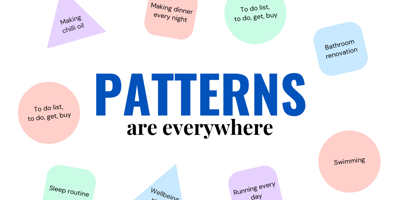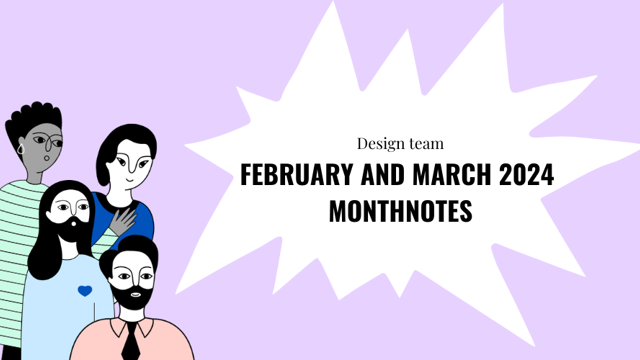The gift of sharing is something we advocate, so we used the 12 days of Christmas song as the inspiration for a series of shares with our colleagues this month. For 12 consecutive days.. we sent out a gift each day on our internal team channel. They went down a treat, so we thought we would share more widely to conclude the 12 days. We cover books, podcasts, talks, courses, and activities.
Our 12 days of Christmas…
On the 1st day
Sarah Fox sent to you the only book you need to get your head around service design: This is Service Design Thinking
I want to share the book that helped me level up my understanding of service design at the start of my career. It’s a great way into service design for non-designers or designers from other specialisms, and there are case studies and essays for more experienced service designers too.
On the 2nd day
Leonardo Gentili sent to you, why the importance of a good warm-up exercise is important
A good warm-up exercise gets people thinking visually. It is a confidence booster before ideation, drawing or even sessions that require logical thinking and concentration.
On the 3rd day
Loren Hansi Gordon sent to you three go-to sources of radical, inclusive design inspiration:
Where design meets art and AI, Healing Justice transforms structural inequality and knowledge is no longer ‘universal’, but plural.
-
Comuzi blending radical insight and creativity, and venturing beyond conventional boundaries.
-
Healing Justice London (HJL) building community-led health and healing to create capacity for personal and structural transformation.
-
Pluriversal Design Sic creating a liberatory and radical space in the design research community to promote/create inter-cultural and pluralistic conversations about design.
On the 4th day
Christine Browne sent to you four podcasts on service design, to help us all succeed:
-
Code Switch
Navigate the complexities of race and culture in America. Hosted by experienced journalists Shereen Marisol Mercantini and Gene Demby, each episode tackles complex issues like racial bias, identity formation, and language. Perfect podcast for service designers seeking a greater understanding of the diverse needs and perspectives.
Code Switch: NPR -
Design Thinking Roundtable
Join a passionate community of service designers as they explore the intricacies of creating delightful user experiences. Each episode is filled with practical tips, insightful chats, thoughtful reflections and real-world examples. Perfect podcast for service designers to learn from experienced designers.
Design Thinking Roundtable – Podcast on Spotify -
Design Matters with Debbie Millman
Through in-depth conversations with renowned designers, artists and thinkers, Debbie Millman explores the challenges, benefits and transformative power of design. Perfect podcast for designers looking to refine their design thinking skills.
Design Matters with Debbie Millman - You’re Wrong About
Each week journalist Sarah Marshall re-examines individuals and events that have been misrepresented by popular culture. Perfect podcast for curious designers!
You're Wrong About
On the 5th day
Jenn Wood sent to you five lessons to effectively influence stakeholders effectively:
-
Service design is only 10% design.
-
There are common reasons services aren’t designed well.
-
Not all stakeholders are equal.
-
We can make a difference.
-
Tell a compelling story to make change happen.
A lack of buy-in can be detrimental. If your stakeholders don’t understand why something is important, they probably won’t do everything they can to support your project and ensure goals are met.
These lessons will help you become more influential in organisations, get buy-in for service design and lead stakeholders to deliver good services.
Jenn will blog about these themes from the Good Services Stakeholder Leadership Masterclass in more detail in the new year.
On the 6th day
Claire O’Brien sent to you a collection of service design tools
Service Design Tools is a good place to start if you want to learn more about service design tools and their application. It features all the classics and more!
On the 7th day
Caitlin Bartlett sent to you a great book: The Service Organisation by Kate Tarling
The Service Organisation is a holistic and practical book. It shows why it’s necessary to create wider conditions in organisations for service design to be successful, particularly at scale. With practical tools about how to do it. Great stuff!
On the 8th day of Christmas
Philip Hotton sent to you an introduction to Susan Weinschenk
A few links to get you started with psychologist Susan Weinschenk:
-
The Top 10 Things You Need to Know about Perception (Youtube video)
-
TheTeamW, a website with tons of content and resources
-
A free course on Behavioral Science from TheTeamW
From the cover of her book, How to Get People to Do Stuff:
"In her 35 year career she has applied what the research in psychology tells us about human behaviour to business situations. She has authored several books on psychology, most recently, 100 Things every designer needs to know about people."
On the 9th day
Natalia Riley sent to you a talk that she and a former colleague (Becky Kuang) delivered at Digital Leaders Week 2023
The talk offers guidance on how different roles in multidisciplinary teams (such as leads, designers, developers) can practically work more inclusively in their day to day.
The talk is based on the concept of psychological safety, and Natalia and Becky’s work developing an inclusive design definition and framework for the NHS.

On the 10th day
I (Jaskiran Kang) sent to you, a warm-up – how to think in patterns
Warm-up task: Write down a pattern you used this week, for example, taking the bins out every Wednesday night for a Thursday morning pickup.
Then think about the process of completing that pattern.
My personal example is growing veg – it takes longer than a week. My process is:
-
plan – when I first started, my plan was low investment, purely experimentation
-
system – you need a system in order to successfully grow vegetables
-
method – Applied design thinking – I discover by expanding my knowledge, then learn by doing (actually growing the veg), then test by trying different ways to keep plants healthy and happy, and finally iterate – keep going, keep growing and see improvements
Our brain is wired to recognise patterns to make sense of the world and structure around us. This is how we need to design services.
On the 11th day
Amanda Johnson sent to you an invitation to read a book with her – ‘From what is to what if’
This book is about reigniting playful imagination as a superpower to address the mess of the climate crisis. Each chapter is brimming with real world examples of creative thinking, drawn from around the world and ranges across education, civic planning, politics and healthcare.
By reading this, Amanda hopes to find inspiration and courage through others’ actions to imagine how to tackle these tricky topics in her own profession as a designer.
At TPXimpact, we’re going to be creating a slack channel for those who want to read along!
Let’s ‘unleash the power of imagination to create the future we want’.
On the 12th day
Katie Dickerson sent to you a blog post from Stéphanie Krus, which follows a talk she presented, showing barriers that all users may face when trying to use a service:
-
Access – having access to a printer, a photo booth, a computer, to a bank account.
-
Awareness – for example, not knowing that that a service exist or that there is a phone line.
-
Comprehension – ability to understand signage at a venue, have the numeracy and literacy skills.
-
Emotional state – feeling psychologically strong enough to take on a task.
-
Enthusiasm/motivation – enthusiasm to try online instead of using the paper form, or to go through a convoluted process.
-
Evidence – having the right document like an invoice in your name, a UK passport, a bank statement or a character witness statement.
-
Fear – fear that using some services will put you at risk - for example, refugee or domestic abuse services.
-
Finance – to use the transport to go to an appointment, to have a document certified, to pay for data or internet, to phone.
-
Self confidence – belief in ability to understand the process or complete the tasks.
-
Time – to fill out forms, to attend an appointment during set hours of the day, to wait for an answer.
-
Trust – confidence that the technology and the people involved will be secure and reliable, that your data won’t be passed on or leaked.
We hope you enjoy these shares and their material here – which might be new for you to enjoy over the festive season. Merry Christmas!
Our recent design blog posts
Transformation is for everyone. We love sharing our thoughts, approaches, learning and research all gained from the work we do.

From Manila to London: Navigating cultures in the TPXimpact Design Academy
Ron Digao shares his journey to our Design Academy and his experience in the programme so far this year.
Read more

